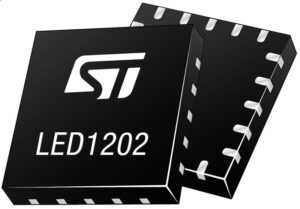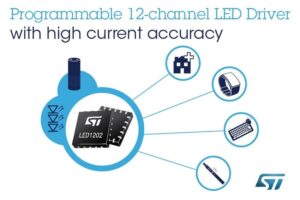The LED1202 is our first 12-channel LED driver with eight programmable patterns capable of automatic sequencing, while its 8-bit analog and 12-bit digital dimming control enable precise lighting effects. Thanks to its ability to feed 20 mA of current to each channel, the LED1202 can power four RGB lights or 12 white ones. Moreover, its small WLCSP20 package (1.71 mm x 2.16 mm x 0.5 mm) will make it easier to implement it in tight designs where space is a major constraint, while its QFN 3×3 housing will help with heat dissipation in PCBs that enjoy larger areas.
Offering users a lighting system that features LEDs for feedback and status updates can often make up for the absence of a display. LEDs can also be a feature as gaming peripherals often advertise what their lighting system can do, for instance. However, LED drivers can be complex to use and require numerous external components. As a result, ST offers a utility to help developers program their effects through a graphical interface while our component’s architecture reduces the number of external devices necessary.
LED Driver with 8 Programmable Patterns for More Autonomous Possibilities

One of the main features of the LED1202 is its support for eight programmable patterns as it gives a significant degree of autonomy to the device. Developers can store each of them in their respective internal I2C register and each LED also uses a dedicated register, which opens a pretty straightforward approach that reduces MCU usage. A program can start a loop calling one or more patterns and run the entire sequence indefinitely or until the user interacts with the system, without ever involving the microcontroller. It is thus a great way to create animations at minimal cost to the power consumption or resources present on the PCB.
To make the application creation process even simpler, we offer a development board and a graphical user interface. The STEVAL-LLL007V1 is an evaluation kit that includes a PCB with three LED1202 and 36 white LEDs as well as two additional panels with 36 white LEDs and 12 RGB LEDs, respectively. The kit works with the STSW-LLL007FW firmware that uses a NUCLEO-L073RZ board as a main host for the STEVAL-LLL007V1. Its buttons can also launch scripts to put the LED1202 in standalone mode to help engineers demo its autonomous capabilities. The STSW-LLL007GUI is a utility that will help visualize the registers and settings to more easily program the driver. It also offers an RGB Mode with white point selection to get accurate colors and manage the red, green, and blue LEDs of each point more straightforwardly.
2 Dimming Controller for More Precision

The presence of an 8-bit analog and 12-bit digital dimming offers excellent precision to augment the device’s lighting effects capabilities. An 8-bit analog controller provides a total of 255 steps ([latex]2^8-1[/latex]), with each step corresponding to approximately 78 µA. The LED1202 is thus able to regulate the current from 1 mA, and up to 20 mA, by increments of about 78 µA, to allow an extremely deep control of LED brightness and color variation. If developers were to decrease the current by one step every second, it’d take about four minutes to go from maximum brightness to an off LED, meaning that an 8-bit controller can offer slow transitions that are more pleasing to the eye and don’t startle the end user.
Additionally, the LED1202 includes a 12-bit PWM dimming controller. This system defines a frame of reference in which the LED will be on for a certain number of steps and then off for the remaining steps. In a 12-bit digital controller, the frame contains 4,095 steps ([latex]2^{12}-1[/latex]). Such a resolution can enable the creation of colors on RGB LEDs that are not possible if there were only an 8-bit analog controller. Moreover, even if such a resolution isn’t always crucial at maximum brightness, it is particularly useful when the LED only emits a few lumens as the human eye becomes much more sensitive to changes. Hence, offering 4,095 steps can make the difference between smooth dimming and abruptly turning an LED off.
1 Global Address for More Practicality
It is easy to overlook the fact that the LED1202 is flexible because it is so expandable thanks to the ability to daisy chain up to eight devices using an I2C protocol. One component acts as the master and shares its clock to all the other slaves to avoid any timing discrepancy. To ensure developers don’t have to start different sequences on each device and deal with lags and delays as each command reaches each device separately, we provide a global address system capable of sending a command to all at the same time. It’s a unique approach in our industry, which allows each device to sequence through their programmable pattern in unison, thus greatly simplifying synchronization and enabling developers to create more complex effects without writing complex code.
It’s easier to daisy chain LED1202 because they all use a tiny package that only necessitates two address pins (A0 and A1), despite their ability to link up to eight devices using I2C. Traditionally, address pins connect to the ground or the Vcc, which allows for only four I2C addresses (GND – GND, GND – Vcc, Vcc – GND, Vcc – Vcc). However, through an innovative solution that we patented, we can also connect the A0 pin to the SDA (data line) and SCL (clock line), which automatically opens up those two pins to a maximum of eight I2C addresses. As a result, it is now possible to daisy chain more components without increasing the package’s footprint or making the PCB more complex.
